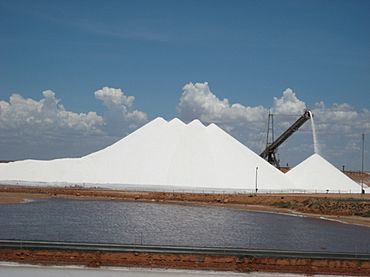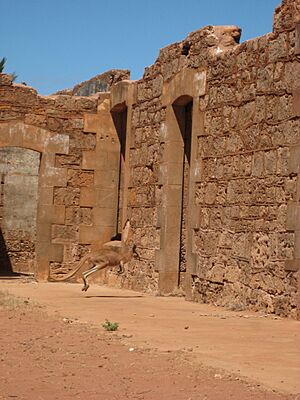Onslow, Western Australia facts for kids
Quick facts for kids OnslowWestern Australia |
|
|---|---|

Salt mine near Onslow
|
|
| Established | 1885 (1925 moved) |
| Postcode(s) | 6710 |
| Elevation | 6 m (20 ft) |
| Area | [convert: needs a number] |
| Location | |
| LGA(s) | Shire of Ashburton |
| State electorate(s) | North West Central |
| Federal Division(s) | Durack |
Onslow is a town located on the coast in the Pilbara region of Western Australia. It is about 1,386 kilometers (861 miles) north of Perth. Around 848 people live in Onslow. The town is part of the Shire of Ashburton, which is like its local government area.
You can get to Onslow by flying into Onslow Airport. The town is also about 76 kilometers (47 miles) away from the main North West Coastal Highway.
Contents
The Story of Onslow: A Town's Journey
Onslow was officially created on October 26, 1885. It was set up as a port town at the mouth of the Ashburton River. Its main job was to help export wool from the many sheep stations in the Pilbara area. The town was named after Sir Alexander Onslow, who was a very important judge in Western Australia at the time.
For about 80 years, wool was the most important business in Onslow. However, the region often faced very dry periods (droughts) and heavy rains (floods). These weather extremes are often linked to whether or not cyclones pass through the area.
Moving Onslow: A New Beginning
The original town of Onslow, sometimes called Old Onslow, had a big jetty (a pier for ships). But it kept getting damaged by cyclones. Also, the river started filling up with sand and mud, making it hard for ships to load and unload. Goods had to be moved from ships in the bay to the jetty using small boats called lighters. Then, they were taken 6 kilometers (3.7 miles) inland to the town by horse-drawn trams.
Because of these problems, the government decided in 1923 to build a new town and jetty. This new spot was 18 kilometers (11 miles) northeast at Beadon Point. The new town was officially named Onslow on January 10, 1924. By 1925, everyone from Old Onslow had moved to the new location. The new jetty was much safer from storms, and the town was closer to the coast, which was more convenient.
Onslow During World War II
During World War II, on May 15, 1943, Onslow became the most southern town in Australia to be bombed by Imperial Japan. A single plane dropped bombs on the airfield, but luckily, no one was hurt and there was no damage.
After the war, the price of wool went down. Even though there was good rainfall for the sheep farms, Onslow's economy started to change. It moved from being mainly about wool to focusing more on tourism. Today, Onslow is a great place to start Coral Coast adventures, like scuba diving on the coral reefs just offshore.
Onslow's Climate: Hot and Wild Weather
Onslow has a hot desert climate. This means it's usually very hot and doesn't get much rain all year. Most of the rain falls in the first half of the year. Only a few months have average high temperatures below 27 °C (80.6 °F).
On January 13, 2022, Onslow recorded an incredibly high temperature of 50.7 °C (123.3 °F). This was the highest temperature ever recorded in Australia, matching a record set in Oodnadatta in 1960!
| Climate data for Onslow | |||||||||||||
|---|---|---|---|---|---|---|---|---|---|---|---|---|---|
| Month | Jan | Feb | Mar | Apr | May | Jun | Jul | Aug | Sep | Oct | Nov | Dec | Year |
| Record high °C (°F) | 50.7 (123.3) |
48.3 (118.9) |
46.2 (115.2) |
43.3 (109.9) |
39.0 (102.2) |
32.7 (90.9) |
32.2 (90.0) |
35.5 (95.9) |
41.7 (107.1) |
44.7 (112.5) |
45.5 (113.9) |
48.7 (119.7) |
50.7 (123.3) |
| Mean daily maximum °C (°F) | 36.5 (97.7) |
36.4 (97.5) |
36.2 (97.2) |
33.9 (93.0) |
29.4 (84.9) |
26.0 (78.8) |
25.5 (77.9) |
27.4 (81.3) |
30.2 (86.4) |
33.0 (91.4) |
34.4 (93.9) |
36.0 (96.8) |
32.1 (89.8) |
| Mean daily minimum °C (°F) | 24.5 (76.1) |
25.1 (77.2) |
24.4 (75.9) |
21.6 (70.9) |
17.5 (63.5) |
14.4 (57.9) |
13.1 (55.6) |
13.7 (56.7) |
15.6 (60.1) |
18.0 (64.4) |
20.2 (68.4) |
22.5 (72.5) |
19.2 (66.6) |
| Record low °C (°F) | 16.6 (61.9) |
15.1 (59.2) |
16.9 (62.4) |
10.9 (51.6) |
8.9 (48.0) |
3.1 (37.6) |
4.6 (40.3) |
5.4 (41.7) |
7.9 (46.2) |
8.9 (48.0) |
12.9 (55.2) |
15.6 (60.1) |
3.1 (37.6) |
| Average rainfall mm (inches) | 35.4 (1.39) |
58.0 (2.28) |
69.0 (2.72) |
12.4 (0.49) |
51.3 (2.02) |
44.8 (1.76) |
18.7 (0.74) |
8.2 (0.32) |
1.5 (0.06) |
0.7 (0.03) |
2.5 (0.10) |
3.2 (0.13) |
305.7 (12.04) |
| Average rainy days (≥ 1 mm) | 2.2 | 2.9 | 2.2 | 1.0 | 2.6 | 2.5 | 1.4 | 0.9 | 0.3 | 0.1 | 0.3 | 0.4 | 16.8 |
Onslow has experienced many extreme weather events. For example, in 1912, it received only 14.5 millimeters (0.57 inches) of rain all year. And between 1935 and 1936, only 126 millimeters (4.96 inches) fell in total.
However, in 1961, a record 997.9 millimeters (39.29 inches) of rain was recorded! Most of this fell in just five weeks, from late January to early March. This was because three cyclones hit the area in a short time. These cyclones brought very heavy rain and strong, damaging winds, causing floods and damage to buildings.
Between 1935 and 1941, Onslow went through a long drought. Only one cyclone hit during this time, in April 1937, but it didn't bring rain to the inland sheep farms. This made things even harder for Onslow.
Powerful Cyclones and Their Impact
Many cyclones have hit Onslow over the years. The first one recorded by European settlers was in 1880.
- On March 28, 1934, a very strong cyclone hit the town. The new jetty was almost completely destroyed, and nearly all the buildings were damaged, with some being ruined.
- Another powerful cyclone crossed the coast at Onslow on February 7, 1963. It damaged almost every building in town. Winds were so strong, reaching 231 kilometers per hour (144 mph), that they bent telephone poles until they were lying flat on the ground!
- On February 19, 1975, Severe Tropical Cyclone Trixie passed very close to Onslow, with its center going right over nearby Mardie. Onslow recorded wind gusts of 246 kilometers per hour (153 mph). At Mardie, the wind gusts were 259 kilometers per hour (161 mph), which was the highest reading the equipment could measure, so they might have been even stronger! At that time, the wind gust recorded at Onslow was the highest ever recorded in Australia.



